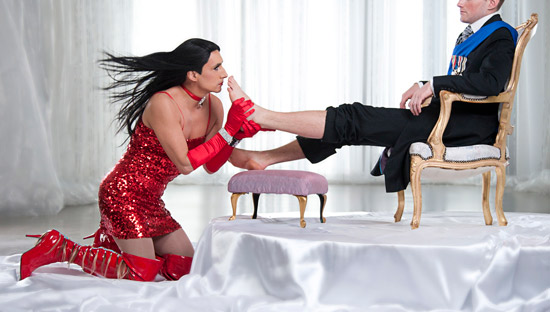Currently on View: Montréal
Kent Monkman “My Treaty Is With The Crown”
Leonard + Bina Ellen Art Gallery
4 March – 16 April 2011
Kent Monkman “Mary” (2011) High definition video. Courtesy Bailey Fine Arts, Toronto
Nearly two decades ago, I visited the National Museum of the American Indian in Harlem (It relocated in One Bowling Green, New York City in 1994). An art student at the time, I was curious to find links between my upbringing in Japanese Shinto religion and the Native American’s worship of nature. I vaguely remember the features of this space, but I did notice that only a handful of visitors were in the museum and, after settling in for a while, I could hear echoes of drumming in the hallways. When I followed the sound I found a man presumably in his early 30s, playing on a traditional animal skin drum, singing a song of folklore. He wasn’t dressed in any overstated ceremonial costume but simply festooned with ornaments on his long dark hair. Children and adults gathered around as the man continued his performance, in this space dimly lit to preserve the nearby artifacts stored behind glass cases. A split-second later, my eyes were blinded by a flash of light, coming from the camera of an elderly person standing next to me. The singing man sternly frowned, ceased playing. He spoke in the elderly person’s direction, in a firm yet polite manner: “Please don’t take my picture because I’m not an exhibition displayâ€. After a measured pause and palpable tension in the air, the man resumed his drumming with dignity.
Kent Monkman’s exhibition “My treaty with the crown†recalled in me this buried memory of the proud signing man, I may have completely forgotten otherwise. The exhibition proffers multilayered narratives and profound symbolism from Monkman’s work, together with other paintings, objects and ornaments from the collection of Montreal Museum of Fine Arts and the McCord Museum of Canadian History.
Miss Chief Eagle Testickle is Monkman’s alter ego, a sexy and framboyant transvestite and a “two-spirit” in native tradition. Monkman uses this central figure within the narrative of his exhibition to create a mise-en-scene based on two highly symbolic historical events. In the first room, two military mesh tents are hung side by side in the middle of the space – the first tent branded with a Union-Jack pattern and the other with a fleur-de-lis. On one side of the tents are exhibited “The Death of General Montcalm†(1760), a painting by Louis Watteau as well as a reproduction of The Death of Wolfe on a 19th Century English platter. On the other side of the tents are displayed Monkman’s paintings of the biblical allegory of Samson and Delilah. Here the nude Miss Chief only is only wearing seven-inch heels and a traditional hair and beads choker, secretly holding a pair of scissors to cut the hair of General Wolfe or maybe Montcalm. The hair she ravages is an obvious symbol of power, strength and knowledge and the ambient sounds of wolves, crickets and breathing, added to this exhibition only accentuate the threat Miss Chief poses to the European generals. Inside the tents Miss Chief leaves traces of her existence as make up markings on the pillows, which also acts as a hybridization between historic documentation and artistic appropriation of this crucial moment in the building of our “Canadian Nationâ€
In the second room Monkman uses another event of historical importance, the 1860 inauguration of Montreal’s Victoria Bridge in the presence of 19 year-old the Prince of Wales (Edward VII). Miss Chief enters this scene only wearing skimpy underwear, thrashing down on her knees to wash the Prince’s feet in penitence, surrounded by both representatives of the Queen Victoria and indigenous people in ceremonial costume. A policeman yanks Miss Chief’s arm to release the prince (and representatives of Queen Victoria) from her grasp. Adjacent to that work of Monkman’s, a classical religious painting of Maria Magdalene, embracing the emblem of penitence and repentance. Monkman continuously immerses us in biblical symbolisms for his narrative to jointly evoke submission and treachery, impudence and transgression.
Kent Monkman “Mary” (2011) High definition video. Courtesy Bailey Fine Arts, Toronto
The third room displays a short video, “Maryâ€, a symbolic play where Miss Chief tries to wash her Prince’s feet in reverie. “I agree to share, not to surrender†says the dreamer, licking the Prince’s bare foot. The latter opens his mouth slightly as if moaning. Tears of black mascara fall down on her face and she cries “How could you break your promise?†The operatic soundtrack intensifying the dramatic mood into pathos.
Monkman disrupts the dominant political forces of history, re-examines traditional perceptions by juxtaposing the documented fact and fiction inspired by the unwritten or distorted history which he deals with whimsically, in a tongue-and-cheek manner. Within his own narrative, he overturns the hierarchy of power from the position of excluded race and gender, to re-write history as well as create a new myths. On this, Monkman most accurately stated: “We cannot escape history, but we can question the subjectivity of those who write it.â€
It has been a long time since Monkman’s exhibition that I witnessed such an instance of dissent in a museum environment. I can only assume this is the result of huge changes in political awareness and tolerance in our society. However, many more drumbeats linger in the hallways of history and need to be heard. My acupuncture doctor once told me that it takes the same length of time to recuperate from the symptoms of an illness as to host its incubation period. And in effect we carry it twice as long in our system as the period when the illness is manifest. With this in mind, even though Miss Chief Eagle Testickle’s mission as a trouble-maker is evident, this two-spirit surely also hold a powerful force as a healer in our troubled history.
Kent Monkman (born 1965, St. Mary’s, Ontario) is an artist of Cree ancestry, working in a variety of media including painting, film/video, performance and installation. Monkman has exhibited widely within Canada, and is well represented in numerous private and public collections including the National Gallery of Canada, the Art Gallery of Ontario, and the Montreal Museum of Fine Arts. He is represented by Galerie Florent Tosin in Berlin, Bailey Fine Arts in Toronto, Trepanier Baer Gallery in Calgary and Pierre-Francois Ouellete Art Contemporain in Montreal. He currently lives and works in Toronto.
Artist’s website: http://kentmonkman.com/main.php
By Miwa Kojima


